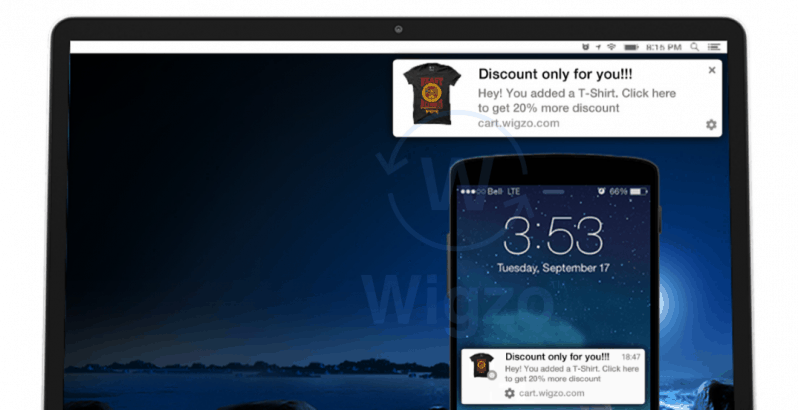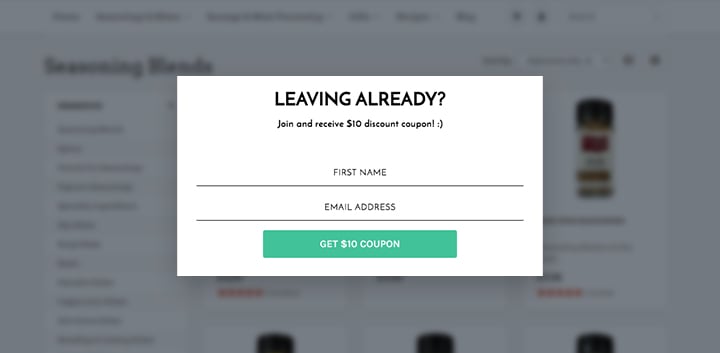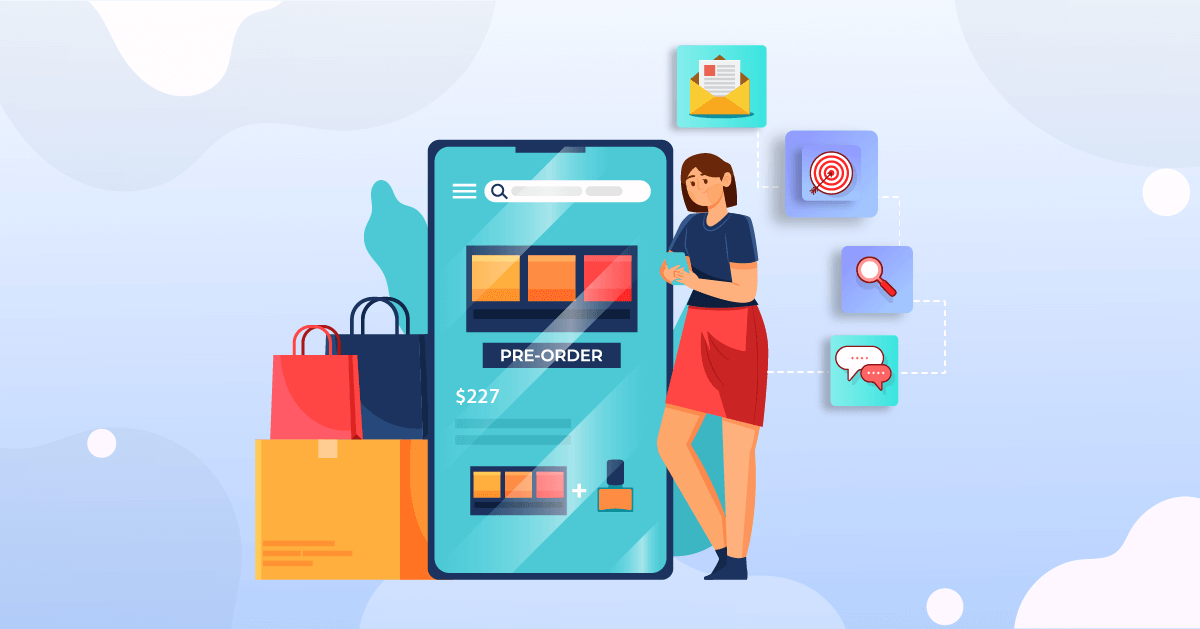Given that the anticipated global retail e-commerce sales growth will shoot from $1.3 trillion in 2014 to $4.9 trillion in 2021 (almost nearly a threefold increase), it seems tempting to take the online plunge. However, do you have all it takes to survive?
Hundreds of e-commerce shops and stores come into business every other day. The reason – it is no longer time-consuming and expensive to create an online e-commerce store. Only a few can thrive. Most probably, they did not take customer engagement seriously.
In 2021, it became all the more critical for businesses to win at customer engagement. With this in mind, we discuss the following five ways your e-commerce store can nail customer engagement.
Best Tips to Nail Customer Engagement for E-commerce Store
1. Customer Engagement with Web Push Notifications
Most visitors are browsing on the move, on mobile, and on tablets. Most purchases are made from the good old laptop or desktop. No matter what device your visitors are using, web push notifications catch attention, and keep users engaged, even when not on the website.
According to DMN news, almost nine out of 10 (89%) millennials are likely to act on a notification received from their favorite brand. The best thing about push notifications – your message is read instantly. Any business is expected to benefit from a communication channel that enables sharing updates immediately and acts upon them in no time. Of course, only if they can get their opt-in strategy right.
Some of the top e-commerce brands improve engagement and sales incredibly by using web push notifications. Though several customer engagement campaigns can be talked about here, the following are our favorite three:
- Cart Recovery – Add to cart is the closest conversion goal to revenue, and drop-offs are disappointing for all e-commerce players. Web push notifications can help recover sales lost because of cart abandonment. Discounts, time-sensitive price alerts, out-of-stock notifications, and few other techniques can help improve click-throughs on web push and re-engage users with their cart.

- Cross-sell – Increase average order value with cross-selling push notification campaigns. If a user has added a mobile phone to his cart, make him buy just a bit more by pushing notifications offering a 10% discount on headphones.
- Fresh Stock Updates – Maybe your users haven’t purchased from you for a while because you don’t have anything new in-store. Get inactive users back to browsing and buying by informing them about fresh items in stock. Send out personalized alerts and based on their behavioral data. For example, if they last visited your ‘fashion jewelry category,’ notify them about the fresh stock that you have added to that category.
2. Customer Engagement with On-site Messaging
On-site messaging or onsite push notifications are similar to web push notifications, with the former appearing only while a user is browsing the website. Showing your users personalized onsite notifications while browsing your website can get them from browsing to buying.

If you shop online frequently, you must have seen such notifications popping up now and then while checking out products or adding a few items to your cart. To your surprise, these seem to catch your interest often. This is because they gauge user behavior and are triggered by specific user actions.
The one best reason marketers must add onsite notifications to their toolkit is that the user doesn’t need to opt-in for these notifications to display. If you are seriously considering this channel of engagement and sales, here are two use cases that might just give you a bit more positive push.
- Advertise Most-viewed Products – Have a visitor on your website browsing through a specific cosmetic brand? Notify that user about the most-viewed or most-purchased items from that brand—Run URL-based targeting for this campaign and set it for all visitors who visit this URL.
- Social Proofing – Booking.com is the perfect example of how on-site notifications can be used to win visitors’ trust. While this is an example from the travel industry, e-commerce businesses too can use onsite notifications to create a sense of confidence in their products and nudge users to buy!
3. Customer Engagement with Exit Intent
One of our client’s case studies is the best example of using exit intent to improve customer engagement. Ethos watch boutique used Wigzo’s exit intent technology to gain back the lost attention of their visitors. Wigzo predicted the visitors’ on-site movements and intent to exit right from the time of the visit. The exit intent campaign primarily worked because Wigzo uses a runs 1:1 personalized campaign powered by machine learning.

For your exit intent campaign to work just like it did for Ethos, you need to design it right. Your messaging should be solid and relevant. Phrases like “Just before you leave” “Don’t leave without checking this out” should be followed with an offer that the potential customer is interested in.
Segmentation can further help you fine-tune your exit intent campaign based on target audience group/groups. Create unique user segments and build campaigns that cater to the interests or likes of these groups. For example, you could segment users who have added products to their wishlist as a user set and run an exit-intent campaign offering a 15% discount on their wishlist.
URL targeting is another technique to strengthen your exit intent. It is a much-refined way of running exit intent campaigns than designing a generic campaign for the entire website. Identify critical pages on your website and build your campaign for visitors browsing those pages. For example, for a visitor reading your blog and just about to leave, offer or invitation to subscribe. Similarly, for someone checking out ‘watches’ on your website, customize the exit intent to say ‘ Before you leave, check out this awesome discount on branded watched.’
4. Customer Engagement with Better Use of Social Media
There can’t be enough stress that social media is ‘the thing to take notice of as a marketer. With more than 2.8 billion people using social media around the globe, it is nothing but evident that that is where people, your target audience, are hanging out. It is one of the most powerful tools that, if properly used, can boost your e-commerce website’s capacity to engage customers and influencing their purchase decision.
Here are a few ways you can use social media as leverage and boot your e-commerce website.
- Optimizing your posts for social media searches can help you increase your visibility in search and reach a wider audience. You need to look for research keywords and hashtags that are popular and are directly related to your business or product(s). You must then strategically incorporate them in your posts and can capture the attention of even busy readers just scanning through.
- Avoiding direct sales pitches in your posts is a good idea. Sharing the right content, such as providing helpful, informative, and share-worthy content geared towards your target audience should be ideal. Provide them with helpful tips. Tell stories. Share news.
- It is also a good idea to use your satisfied customers as leverage by sharing their precious reviews on your products or services. Using your reviews can help develop a positive image of your brand, products, and services even before they begin doing any business with you.
- Add social sharing buttons. This feature is gaining immense popularity and comparatively is relatively easy to implement. There are many options available. Feel free to try and see which one works the best for you.
- As much as possible, make it a point to interact with your followers directly and daily. Monitor your posts. Ask questions. Thank them for sharing any of your content. Reply to comments and messages as soon as possible.
- Do not allow any of your e-commerce website’s social media accounts to stagnate. Be consistent. This is critical in improving your customer engagement and also aid in driving more traffic to your website. Schedule your posts in advance using automation tools.
5. Customer Engagement with Ultra Personalized Outreach
96% of marketers and executives believe in the value of personalization, with very few disinterested in the idea or notion of its importance. We are aware by now that personalization makes customers feel unique with those personal and relevant conversations, further forcing them to notice your sales pitch.
The idea of personalization works around the varied interests exhibited by shoppers in their past interactions with your brand. Identify the critical parameters, segment customers based on them, and then target them—this is the ideal strategy that has proven to work in beefing up customer engagement in the past.
Advanced personalization tools and techniques customize every aspect of a customer journey to what the brand offers. Personalization creates a sense of uniqueness and individuality for customers as they feel unique and vital as if the brand is paying particular extra attention to them. Moreover, by segmenting and targeting different visitor profiles, personalization answers each customer’s individual needs, thereby optimizing customer experiences rather than sending one message that fits all average expertise to all.
To Wrap Up
Email marketing and social commerce are something that everyone is doing to build brand awareness and recall. However, to gain that upper edge over customer engagement, your business needs something that has the power to catch users in the moment. Web push notifications, onsite massages, and exit intent technology are three such techniques that can help you engage with your users more meaningfully at the right time.













